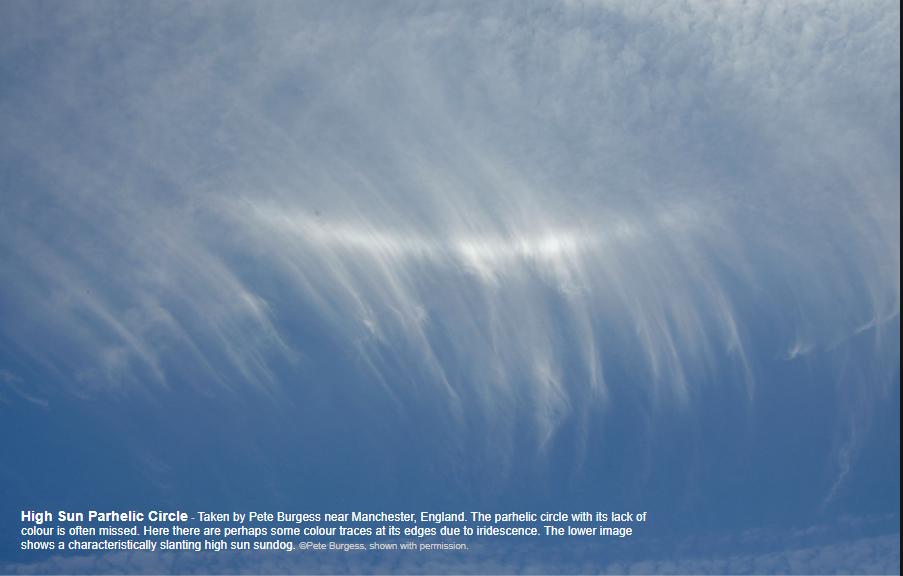High Sun at Manchester
High Sun at Manchester: A Phenomenon of Atmospheric Optics
The phenomenon of a high sun at Manchester is a captivating display of atmospheric optics that occurs when the sun is positioned high in the sky, creating unique optical effects. This article explores the mesmerizing phenomena associated with a high sun and delves into the intricacies of its occurrence.
What is a High Sun?
A high sun refers to the position of the sun in the sky when it is at its highest point during the day. In locations closer to the equator, the sun reaches higher altitudes throughout the year compared to locations farther from the equator. Manchester, England, being at a relatively higher latitude, experiences a high sun during certain times of the year.
The Parhelic Circle: A Subtle Beauty
One fascinating feature associated with a high sun is the parhelic circle. This circular band of light is often overlooked due to its lack of color. However, keen observers might notice subtle traces of color at its edges caused by iridescence. The parhelic circle can be observed around the same altitude as the sun and is a result of sunlight interacting with ice crystals in the atmosphere.
Sundogs: Slanting Marvels
Another enchanting phenomenon that occurs during a high sun at Manchester is the appearance of sundogs. Sundogs are bright spots of light that appear on either side of the sun, forming a triangle of light with the sun at its apex. These slanting sundogs are characteristic of a high sun and are caused by the refraction and reflection of sunlight by ice crystals in the atmosphere.
Iridescence: A Touch of Color
Iridescence, often observed at the edges of the parhelic circle, adds a touch of color to the high sun display. This optical phenomenon occurs when light is diffracted, or bent, by small water droplets or ice crystals in the atmosphere. The diffracted light separates into its component colors, creating a beautiful display of hues.
Atmospheric Conditions and High Sun Events
The occurrence of a high sun and its associated optical phenomena is influenced by various atmospheric conditions. Here are some factors that contribute to the occurrence of a high sun event at Manchester:
-
Latitude: Manchester's higher latitude means that the sun reaches greater altitudes during certain times of the year, providing the opportunity for a high sun display.
-
Time of Year: High sun events are more likely to occur during the summer months when the sun is at its highest point in the sky.
-
Weather Conditions: Clear skies are essential for optimal viewing of a high sun event. Cloud cover can obstruct the visibility of the phenomena, making them harder to observe.
Capturing the Beauty: Photography Tips
For photography enthusiasts, capturing the beauty of a high sun event can be a rewarding experience. Here are some tips to enhance your chances of capturing stunning images:
-
Use a Polarizing Filter: A polarizing filter helps reduce glare and enhance color saturation, making the optical phenomena more pronounced in your photographs.
-
Timing is Key: Plan your photography session during the hours when the sun is at its highest point. This will provide the best lighting conditions for capturing the phenomena.
-
Experiment with Angles: Explore different angles and compositions to capture unique perspectives of the high sun and its associated optical effects.
Appreciating Nature's Wonders
Witnessing a high sun event at Manchester is a reminder of the awe-inspiring wonders that nature has to offer. These atmospheric optics phenomena serve as a testament to the intricate interplay between sunlight, ice crystals, and water droplets in our atmosphere. By taking the time to observe and appreciate these displays, we can gain a deeper understanding of the fascinating world of atmospheric optics.
In conclusion, a high sun at Manchester presents a captivating spectacle of atmospheric optics. From the subtle beauty of the parhelic circle to the slanting marvels of sundogs, these phenomena offer a glimpse into the mesmerizing interactions between sunlight and the atmosphere. By embracing the opportunity to witness and photograph these events, we can truly appreciate the wonders that nature bestows upon us. So, keep your eyes to the sky and be prepared to be amazed by the magic of a high sun at Manchester.

High Sun Parhelic Circle - Taken by Pete Burgess near Manchester, England. The parhelic circle with its lack of colour is often missed. Here there are perhaps some colour traces at its edges due to iridescence. The lower image shows a characteristically slanting high sun sundog. ©Pete Burgess, shown with permission.

Note: this article has been automatically converted from the old site and may not appear as intended. You can find the original article here.
Reference Atmospheric Optics
If you use any of the definitions, information, or data presented on Atmospheric Optics, please copy the link or reference below to properly credit us as the reference source. Thank you!
-
<a href="https://atoptics.co.uk/blog/high-sun-at-manchester/">High Sun at Manchester</a>
-
"High Sun at Manchester". Atmospheric Optics. Accessed on November 24, 2024. https://atoptics.co.uk/blog/high-sun-at-manchester/.
-
"High Sun at Manchester". Atmospheric Optics, https://atoptics.co.uk/blog/high-sun-at-manchester/. Accessed 24 November, 2024
-
High Sun at Manchester. Atmospheric Optics. Retrieved from https://atoptics.co.uk/blog/high-sun-at-manchester/.